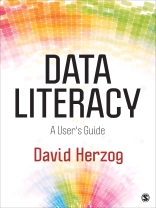A practical, skill-based introduction to data analysis and literacy
We are swimming in a world of data, and this handy guide will keep you afloat while you learn to make sense of it all. In
Data Literacy: A User′s Guide, David Herzog, a journalist with a decade of experience using data analysis to transform information into captivating storytelling, introduces students and professionals to the fundamentals of data literacy, a key skill in today’s world. Assuming the reader has no advanced knowledge of data analysis or statistics, this book shows how to create insight from publicly-available data through exercises using simple Excel functions. Extensively illustrated, step-by-step instructions within a concise, yet comprehensive, reference will help readers identify, obtain, evaluate, clean, analyze and visualize data. A concluding chapter introduces more sophisticated data analysis methods and tools including database managers such as Microsoft Access and My SQL and standalone statistical programs such as SPSS, SAS and R.
Innehållsförteckning
Chapter 1: Data Defined
Climbing the pyramid
A brief history of the data world
Data file formats
Chapter 2: Clues for uncovering data
Why agencies collect, analyze, publish data
Clues from data entry
Clues from reports
Tricks to uncover forms and reports
On your own
Chapter 3: Online databases
Destination: data portals
Statistical stockpiles
Agency sites
Non-governmental resources
Data search tricks
Don’t forget the road map
On your own
Chapter 4: Identifying and requesting offline data
Other clues for offline data
Find the data nerd
Requesting the data
Writing the data request
FOIA in action
Negotiating through obstacles
Getting help
On your own
Chapter 5: Data dirt is everywhere
All data are dirty
Detecting dirt in agricultural data
Changed rules = changed data
On your own
Chapter 6: Data integrity checks
Big-picture checks
Detailed checks
On your own
Chapter 7: Getting your data in shape
Column carving
Concatenate to paste
Date tricks
Power scrubbing with Open Refine
Extracting data from PDFs
On your own
Chapter 8: Number summaries and comparisons
Simple summary statistics
Compared to what?
Benchmarking
On your own
Chapter 9: Calculating summary statistics and number comparisons
Sum crimes by year
Minimum and maximum numbers
Amount change
Stepping up to percent change
Running rates
Running ratios
Percent of total
More summarizing
On your own
Chapter 10: Spreadsheets as database managers
Sorting
Filtering records
Grouping and summarizing
On your own
Chapter 11: Visualizing your data
Data visualization defined
Some best practices
Chapter 12: Charting choices
Visualizing data with charts
On your own
Chapter 13: Charting in Excel
Pie chart
Horizontal bar charts
Column and line charts
Scatterplot
Stock chart
Sparklines
On your own
Chapter 14: Charting with Web tools
Online visualization options
Evaluating web visualization platforms
Creating Fusion Table charts
On your own
Chapter 15: Taking analysis to the next level
Database managers
Statistical programs
Om författaren
David Herzog is an associate professor at the Missouri School of Journalism, where he also serves as the academic adviser to the National Institute for Computer-Assisted Reporting. He was a fellow at the Reynolds Journalism Institute, where he launched Open Missouri.org, a directory of data held offline by state agencies. Before arriving at the School of Journalism in 2002, he worked as a newspaper reporter at The Providence Journal, The Baltimore Sun and The Morning Call in Allentown, PA. He is a native of Bethlehem, PA.












